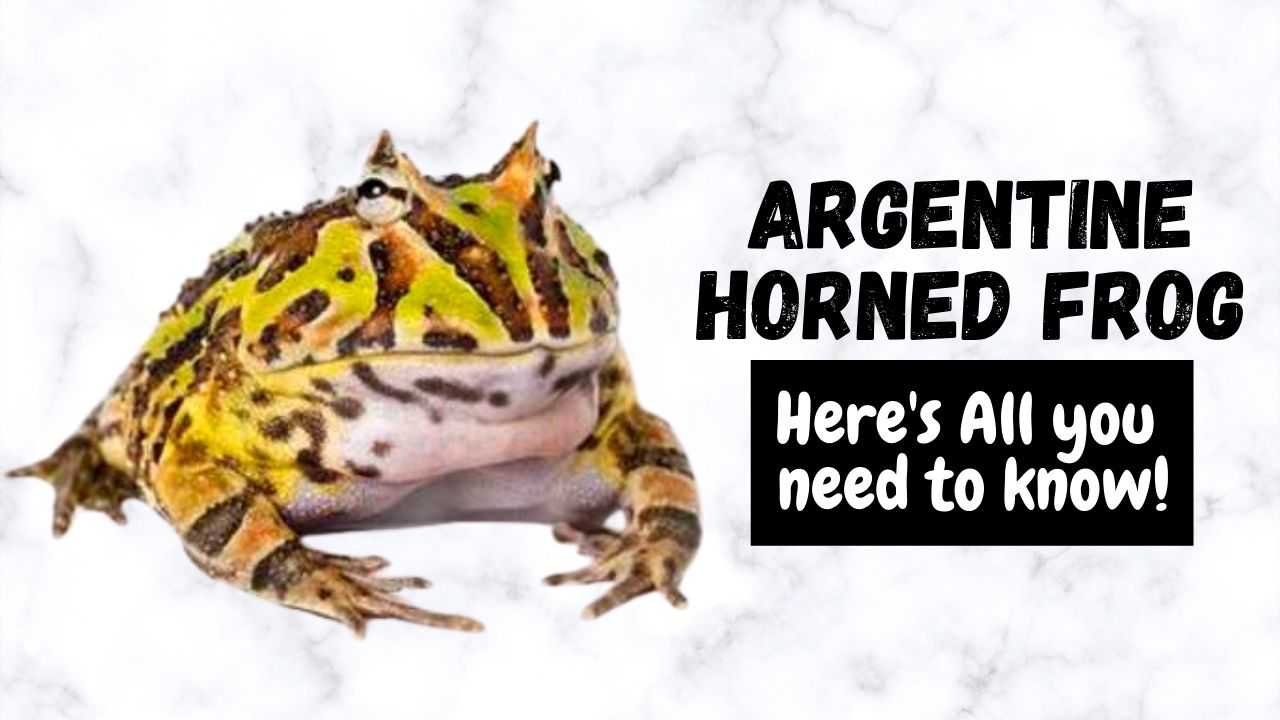About Argentina Horned Frog
The Argentine Horned Frog, also named as the (Ornate Pacman Frog or the Argentina Wide-Mouthed Frog), belongs to the Ceratophryidae family. This amphibian is endemic to Uruguay, Brazil, and Argentina — while the name “horned frog” comes from the folds of skin that are located over the eyes. They spend most of their time hiding on the forest floor covered with leaves in expectation of their meal to move close to its mouth.
Being a voracious eater, the Argentine Horned Frog swallows everything that fits into its big mouth— ranging from small invertebrates to insects. These frogs are belligerent, slothful, and large-sized. They are deemed among the world’s largest frog species. Females are bigger than males and have a camouflaged color scheme on their bodies.
Physical Appearance
The Argentine horned frog is an amphibian with a round, heavy squat body, strong legs, and a wide jaw to swallow even a mouse. Moreover, they are known for their extremely large heads and coloration. Argentina wide-mouthed frogs have yellow or white underbellies, and their limbs and back ranges in coloration — are typically bright green with red markings, though parti-color black, dark green and albino versions also exist, that provides superlative camouflage by breaking up the frog”s outline.
Size/Weight/Life Span
As written above — females are much larger in size than males. A female Argentine Frog can grow up to 15 cm, while males go up to 12 cm. They weigh between 0.8 lb to 1 lb. These big-mouthed frogs tend to live around 5-7 years in the wild, while in captivity they can survive up to 15 years.
Geographical Range/Habitat
The Argentine horned frogs are indigenous to South America, Uruguay, Eastern Brazil, Grande Do Sul, and Northern Argentina. Studies have discovered these amphibians to be adaptive to tropical rain forest regions that contain plenty of damp vegetation and in the woodlands near areas with shallow water.
Diet
Being rapacious they feed up on everything, but the staple food of horned frogs is usually insects, which generally makes up around 60% of their diet. Other than that, they consume small reptiles, birds, and invertebrates.
Behavior
Argentine Wide-Mouthed Frog habitually gets active at night and hibernates during the winter under piles of rotting leaves, in mud ponds, or under the stones and logs. Furthermore, if the Argentina horned frog environment gets dry or loses its food source, at that point this creature will encase itself inside a tough external layer of skin for safekeeping. In this situation the frog remains still, giving the intruders an expression of being dead. When the frog becomes re-hydrated, it sheds the strong external skin layer and ingests it.
Ornate Pacman frogs are intrepid — at times they even attempt to swallow animals almost the same size as they are. They camouflage themselves in such a way that it’s difficult for even
humans to spot it. If it feels threatened, it jumps forward and attacks its predators by delivering a strong painful bite. The voraciousness of this amphibian grants it a cannibalize nature, which means they sometimes hunt or swallow their frog species as well!
Reproduction
As discussed above, Argentine horned frogs are nocturnal, and only venture into the jungle when they feel the desire to lay eggs or for mating. During reproduction or mating, they conceal themselves under the rotten leaves, completely vigilant of their surroundings with only their eyes prominent. Females usually lay around 1000 to 2000 eggs — that usually hatch between two weeks and these tiny tadpoles reach their sexual maturity in between the period of 18 to 24 months.
As a Pet
If you are considering this amphibian as a pet, it might not be a good option for owners who want an active playful pet — because the Argentine horned frog is highly motionless and spends most of its time under the leaves and rocks. But the ones who cannot afford expenses and direly need a pet, Argentina horned frog is a good option to opt for because they need a small 10 to 20-gallon aquarium to live in with getting fed only once a week or so. Moreover, be cautious while feeding them — its been reported that in many cases they bite their own owner’s hand.
INTERESTING FACTS:
- Argentine horned frogs are also known as Argentine Wide Mouthed Frog, Ornate Horned Frog, South American Ornate Horned Frog, Bell Horned Frog, Horned Frog, and Pacman Frog.
- Argentine horned frog belongs to the family of Ceratophryidae.
- They are native to Uruguay, South America, Eastern Brazil, Grande Do Sul, and Northern Argentina.
- Ornate horned frogs are recognized by their easily prominent horn located above the eyes.
- Their mouth is as big as their body.
- They have distinctive hues on their skin ranging from dark green to green-yellow with black or red spots.
- Argentine horned frog ranges in size between 10 to 15 cm.
- Female frogs are bigger than males.
- Females lay usually between 1000 to 2000 eggs.
- They are of nocturnal behavior.
- Swallows everything that comes fit in their mouth — even sometimes frogs from their family species.
- An argentine horned frog can’t jump like other frog species.
- They don’t have a long tongue like other frogs.
- Whenever they feel threatened they puff up and start to make screaming sounds.








